History of the StFX University Chapel
Artwork in the Chapel:
The Parousia Mural
Emmanuel: Tabernacle
Emmanuel: Panel
Emmanuel: Bronze Sanctuary Lamp
Emmanuel: Altar and Lettering
The Magnificat Panel
Magnificat Lettering
The Fourteen Stations of the Cross The Celtic Cross
The Fifteenth Station: Christ is Risen
Stained Glass Windows
Bronze Sculpture of St. Francis Xavier
Painting of St. Francis Xavier
History of the StFX university chapel
The St. Francis Xavier University Chapel was designed by American architect Jens F. Larson. Archbishop James Morrison opened the new chapel for divine worship on October 31, 1948. Monsignor P. J. Nicholson, president, and Monsignor H. P. MacPherson, president emeritus, were in the sanctuary for the opening service. The solemn dedication of the Chapel to the patron saint of the University took place during the commencement exercises in May, 1949.
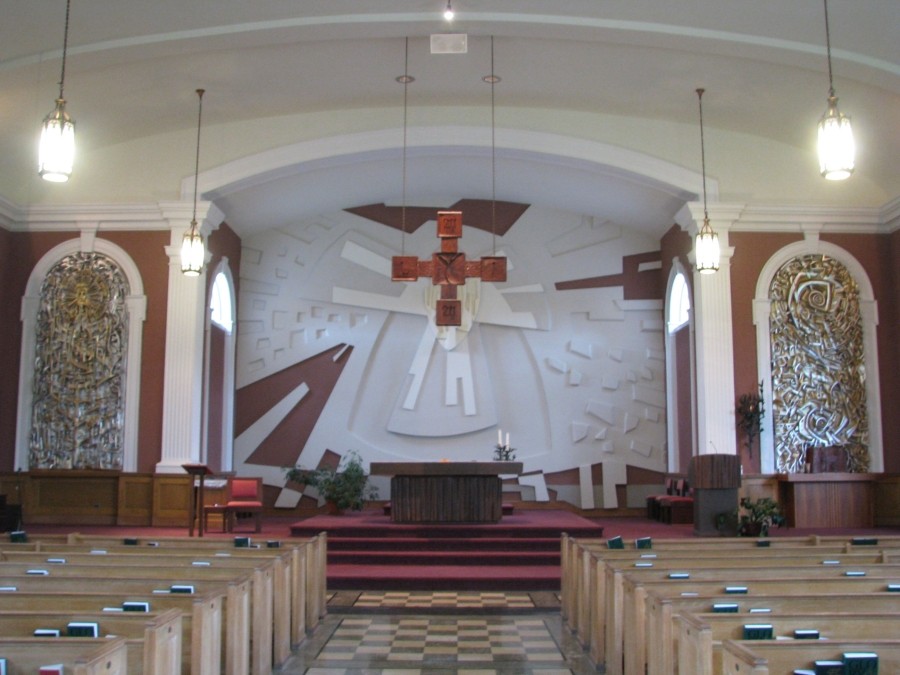
The Second Vatican Council opened on October 11, 1962, at St. Peter’s Basilica in Rome. Most Reverend William E. Power, the Bishop of Antigonish, was one of some twenty-five hundred bishops who participated over a three year period. In 1965, Revered Dr. Malcolm A. MacLellan hired Earl Neiman to design plans for renovating the Chapel interior to bring it in harmony with the liturgical changes advocated at the Council. Most of the work was completed over a period of several years, but Maria Gamundi Neiman’s sanctuary lamp and candelabrum, and some stained glass work were added in the eighties. Earl Neiman’s sculpture of St. Francis Xavier, the major piece, was completed in 1988 during the presidency of Revered Dr. Gregory A. MacKinnon.
All great art is spiritual in nature and function. Sacred art is spiritual art at its height. It can also be called religious art because of its subject matter, which in this case has to do with the teachings of the Catholic faith. Since the art work in the Chapel is a sort of “visual creed,” a brief summary of these beliefs will help the viewer grasp its meaning.
The human mind, limited as it is, cannot grasp the “Other.” However God could reveal Himself to the human family if He so willed. This well known passage from Sacred Scripture, John 3: 14, reveals that this actually happened: “God so loved the world that He sent his only begotten Son so that those who believe in Him might not perish, but have eternal life.” The Word has made flesh and dwelt among us. Our Saviour, a man like us in all things but sin, was conceived through the power of the Holy Spirit and born of the Virgin Mary. Christ was of two natures in one Person, Who was at once God and man. He declared: I am the Way, the Truth and the Life.” (John 14:6) This living Truth told us about God, the Father and how much He loves us, and revealed the Holy Spirit as the Sanctifier.
Christ’s death on the cross is both the Paschal (From Hebrew Pesach: Passover) Sacrifice in which “the Lamb of God takes away the sin of the world,” (John 1:29) and the Sacrifice which restores mankind to communion with God through the “blood of the New Covenant which was poured out of many for the forgiveness of sins.” (Matthew 26:28) The Truth of Christ is revealed to us in the Scripture, and the Life of Christ is accessible in the Eucharist. The Eucharist (The Paschal Sacrifice or the Mass) is the marvelous means of freeing the humanity of Christ from the confines of space and time, so that today we share in one Bread, and be united in the one Body of the Lord. The Eucharistic mystery is the means to bring about Christ’s prayer for unity: “With Me in them and You in Me, may they be so completely one that the world will realize that it was You who sent Me and that I have loved them as much as You loved Me.”(John 17:23) The presence of Christ under the sacred species reserved after Mass in the tabernacle derives from the celebration of the Eucharist and is directed towards communion, both sacramental and spiritual. This accounts for the special attention frequently lavished on the tabernacle by its decoration and prominence in many churches. Baptism, the sacrament of faith, is the source of new life in Christ. Christians believe the truths revealed by God because God’s authority rather than the evidence given. To believe God’s revelation, we exercise our faith by a kind of co-working with God. (1 Corinthians 2:9-16) And now to the art.
The Parousia Mural
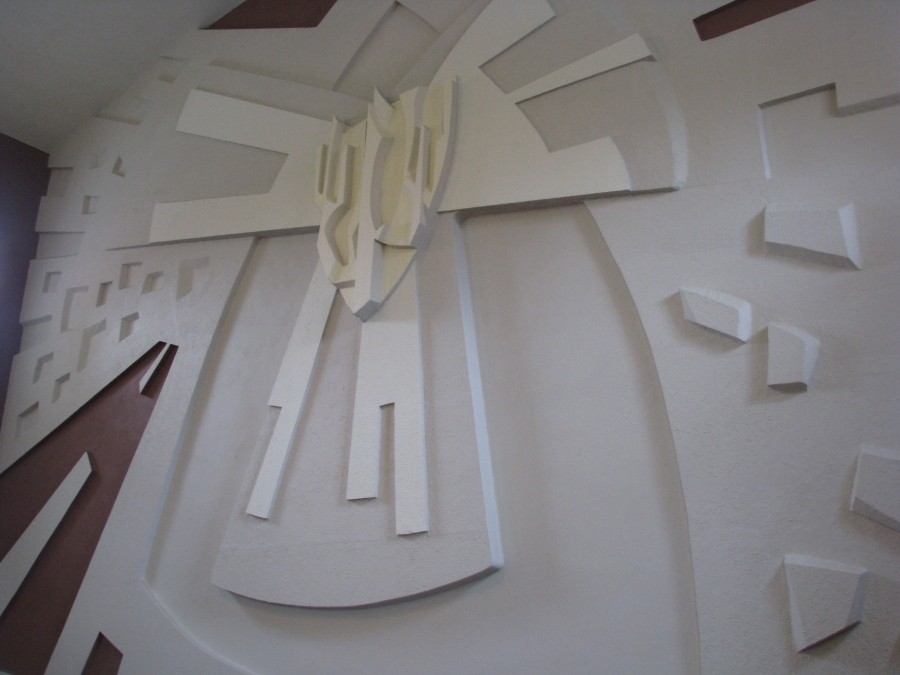
The artist described the main mural as the Parousia, a Greek work meaning presence. It refers to the Second Coming of Christ to earth (1 Corinthians 15:23) foretold by Jesus Himself, by St. Paul, and in several passages in the New Testament of the Bible. At the centre is the triangle, the simplest sign of the invisible Trinity where all three Persons, Father, Son and Holy Spirit, are equally eternal and eternally equal. This dominant shape, by its scale and amplitude, holds everything in balance. At the core of the design, the Father is represented as white hot flames: the consuming and purifying fire of God’s love. No one has seen the Father, Our Lord tells us, but Yahweh (Hebrew name of God) chose fire to appear to the chosen in the Old Testament. The Holy Spirit emanates from the triangle as a three-rayed emission of God’s love. The fact that there is no distinctive representation of the Son on the mural is not an oversight, but an ingenious reminder that the Son became man and lived on this earth. He humbled Himself to share in our humanity so that we could share in His divinity. Look up and you will see the Son of God, our Redeemer, is represented in the Chapel by the great cross suspended before the mural. Its location is also a graphic reminder that no one can arrive at the Parousia without going through the cross. “No one come to the Father expect through Me.” (John 14:6) The cross is the Way of Christ.
These are two aspects of the Parousia mural that suggest a cosmic dimension, an appropriate emphasis for those who live in the Space Age. One is the preponderance of diagonal lines which convey a strong sense of dynamic movement bursting out from the centre, a movement bursting out from the centre, a movement that seems to break through the earth-bound dimensions of the mural and continue on into space. The other is a centrifugal movement caused by manipulating perspective to create an “in on the left and out on the right” sensation. The disparity in size between the smaller shapes hurtling through space and the central triangle makes the latter seem even larger and more dominant. It holds everything in balance.
Earl Neiman was a man of his age. Although he was a great draughtsman and could paint like Rubens, he was fascinated by new materials and influenced by the incentive spirit of the times. In 1954 Dow Chemical introduced a foamed polystyrene by the trademark name Styrofoam. Earl was one of the first to see its possibilities as an art medium on both interior and exterior surfaces. He used this material on the mural and two sides panels in the Chapel. In the main mural he wanted to approximate the surface texture similar to that of the stucco walls. He achieved this rough surface by choosing a good quality, latex house paint and mixing in fine-sand patching cement (quick drying) so that the mixture could be brushed easily or toweled.
To warm up the grey interior, Neiman had suggested that the walls be painted terra cotta. Since he envisaged the grey as representing the sky, and the terra cotta the earth, he used variations of grey and off-white in the mural to contrast with the molding, wall and ceiling colours. Thus the mural also acted as a key to link together all the colours in the Chapel. Neiman deliberately kept the mural neutral in colour because he did not want to intrude upon the liturgy. He thought that this background presented an ideal backdrop to set off the chasuble (little house), the outer liturgical vestment worn by the celebrant at Mass. The classic form of the chasuble almost covers the wearer. In celebrating the liturgy, the priest uses different coloured vestments according to the feast or liturgical season. The neutral colour of the mural also provides an effective contrast to the dark walnut cross that stands out so vividly against it.
Emmanuel: Tabernacle
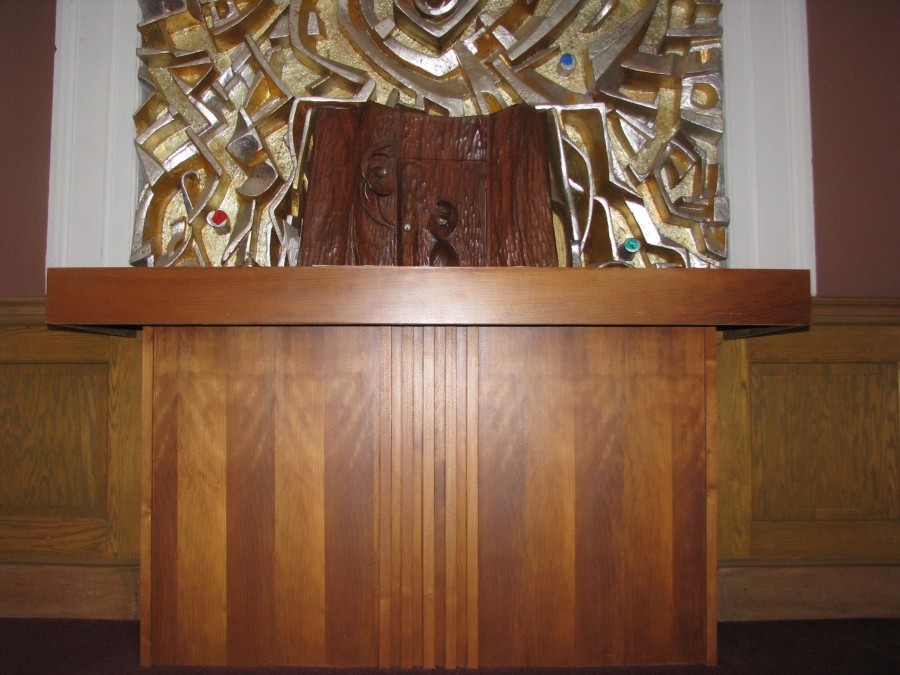
To the right of the Parousia mural is the tabernacle where the Blessed Sacrament is kept. Angus Macgillivray modeled his tabernacle after the description in the Book of Exodus of the Ark of the Covenant, a receptacle made of acacia wood, which Moses had built to house the tablets of the Mosaic Law, i.e., the Ten Commandments. (Exodus 25:10-11)
Two cherubs were to adorn the throne of mercy which was to be placed on the top of the ark. Angus carved his two angels in relief on the dark walnut, and followed the instructions in Exodus that the cherubs must face each other and their wings are to spread upwards. (Exodus 25:18-21) Since the tabernacle is referred to in the Old Testament of the Bible as the Tent of Meeting (Exodus 40:7), Macgillivray carved his tabernacle in the shape of a desert tent draped over its supporting poles. Angus bent the knee of his heart before this ‘Ark of the Covenant’ tabernacle. The two angels bespeak his reverence.
Emmanuel: Panel
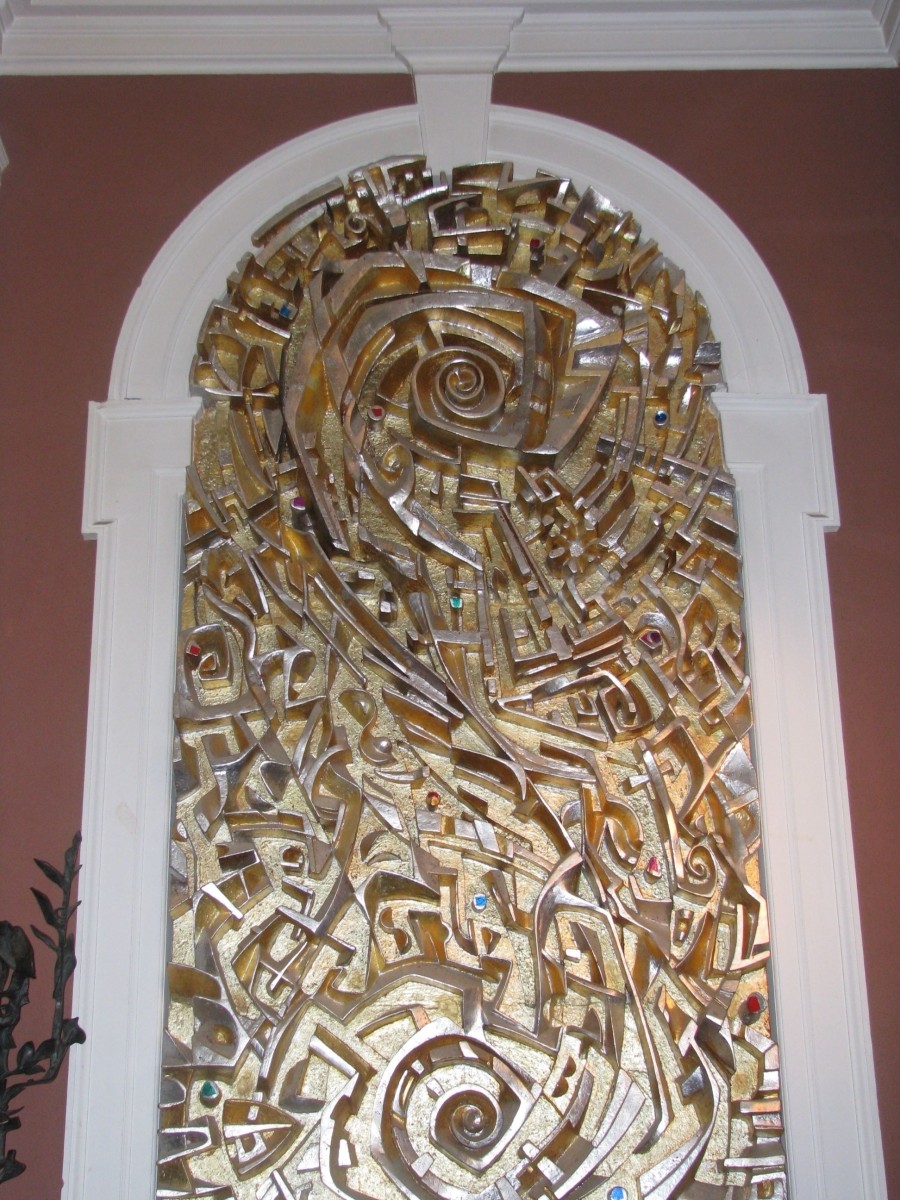
In Exodus, God’s presence is manifested by the glory of Yahweh, a brilliant fire representing God’s unapproachable majesty. Earl Neiman suggests that with gold being the dominant colour throughout the Emmanuel panel, and silver in the background. The whole composition is enlivened here and there by small jewels of colour placed so as to lead they up and around the endless spiraling. Neiman, at that time, had recently traveled throughout Europe and was thrilled with Baroque architecture and the quintessential Baroque painter, Rubens, of whom it was said that he painted with his blood. In this panel, the texture is baroque to the maximum.
Whereas the Parousia mural was deliberately subdued in colour to allow the Mass itself and its accoutrement to provide the focus, Earl Neiman thought that the shrine of the Eucharistic presence, the centre of private devotion, ought to be richer and more distinctive. In contrast to and to differentiate from the place of assembly, Neiman molded a large sculptural jewel somewhat like a permanent monstrance. The monstrance (from the Latin monstrare, to show) is a sacred vessel used for exposition of the Blessed Sacrament. It has a round glass opening through which the Sacred Host can be seen. The glass enclosure is often surrounded by rays or other decorations, indicating the spiritual blessings that flow from the Holy Eucharist upon those who adore and worship Neiman chose the motif of the spiral, a device dating back to Neolithic times. Since it was often found at grave sites and temples, the symbol may have had some religious meaning. Perhaps the outward, spiral, reaching upward might represent the soul’s longing for a transcendent God, while the inward spiral might represent God’s nearness or immanence. How appropriate it this instance. The Greek poet, Pindar (518-438 BC), never dreamed that his claim, “One is the race of gods and men,” might be authenticated in such amazing fashion as when the Logos took flesh in Christ. “In the tender compassion of our God the dawn from on high shall break upon us, to shine on those who dwell in darkness and the shadow of death, and to guide our feet into the way of peace.” (Luke 1:78-79). The Word became flesh, and dwelt among us. Since the Sacred Host hides the humanity and divinity of Christ, today’s followers of Jesus may find it more difficult to appreciate the essence of the Eucharist than the Jews who could at least see Christ’s miracles which attested to His divinity. This where the theological virtue of Faith, received in Baptism, comes into play. Our understanding of revelation is based on Faith. By a kind of working together with God, we an understand the very things God has revealed to us through the Spirit, the Spirit reaches the depths of everything, even the depths of God. (1 Corinthians 2:19)
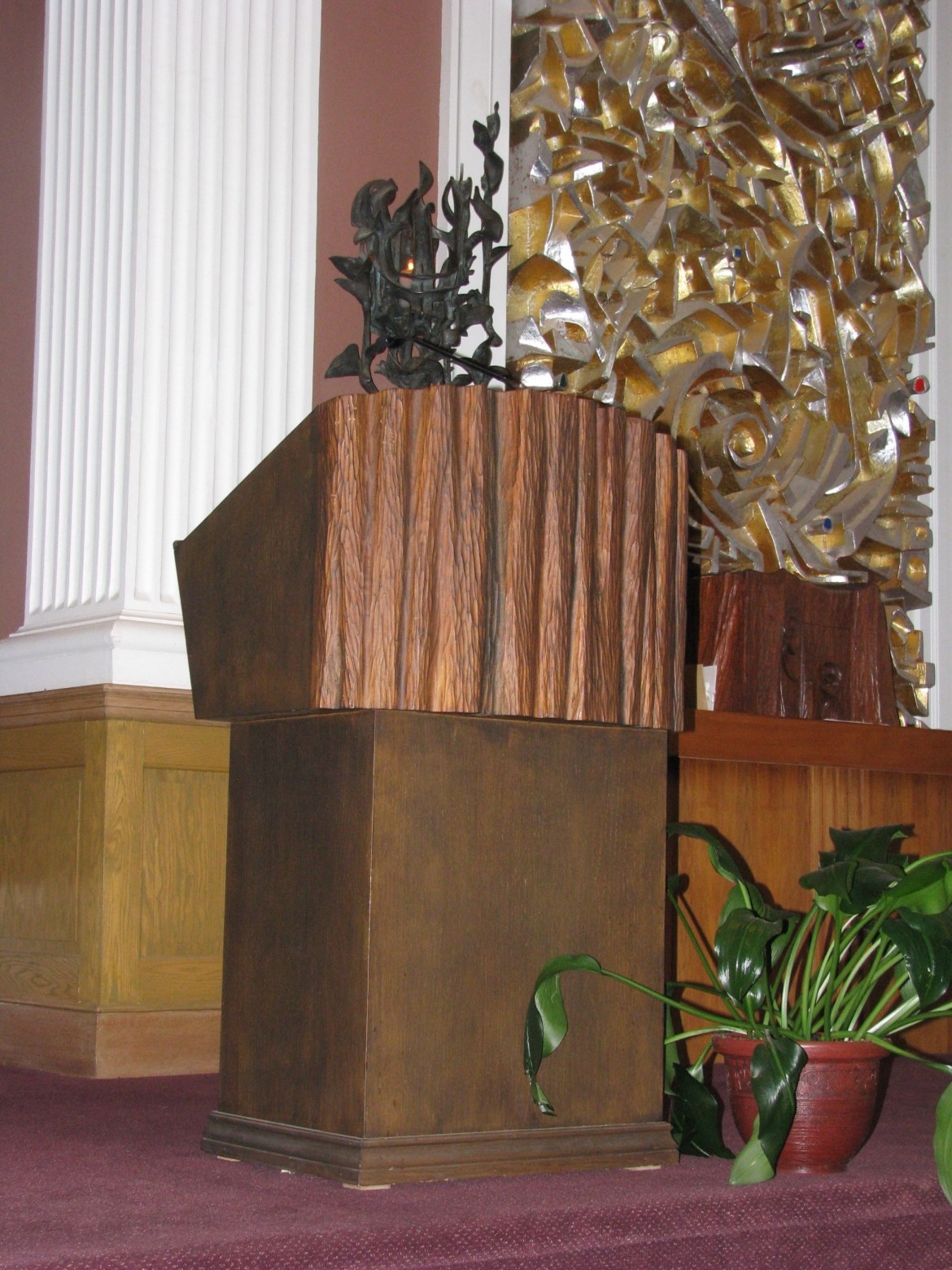
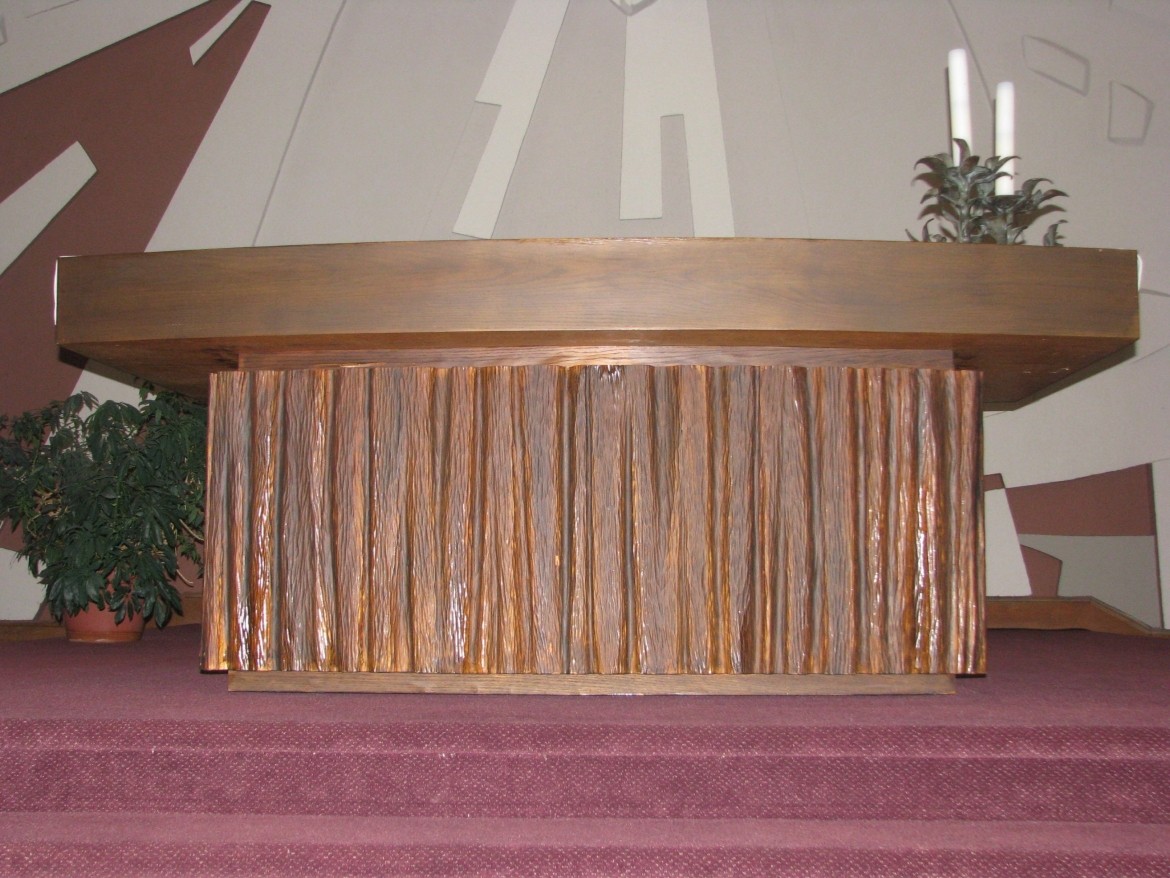
Emmanuel: Bronze sanctuary lamp
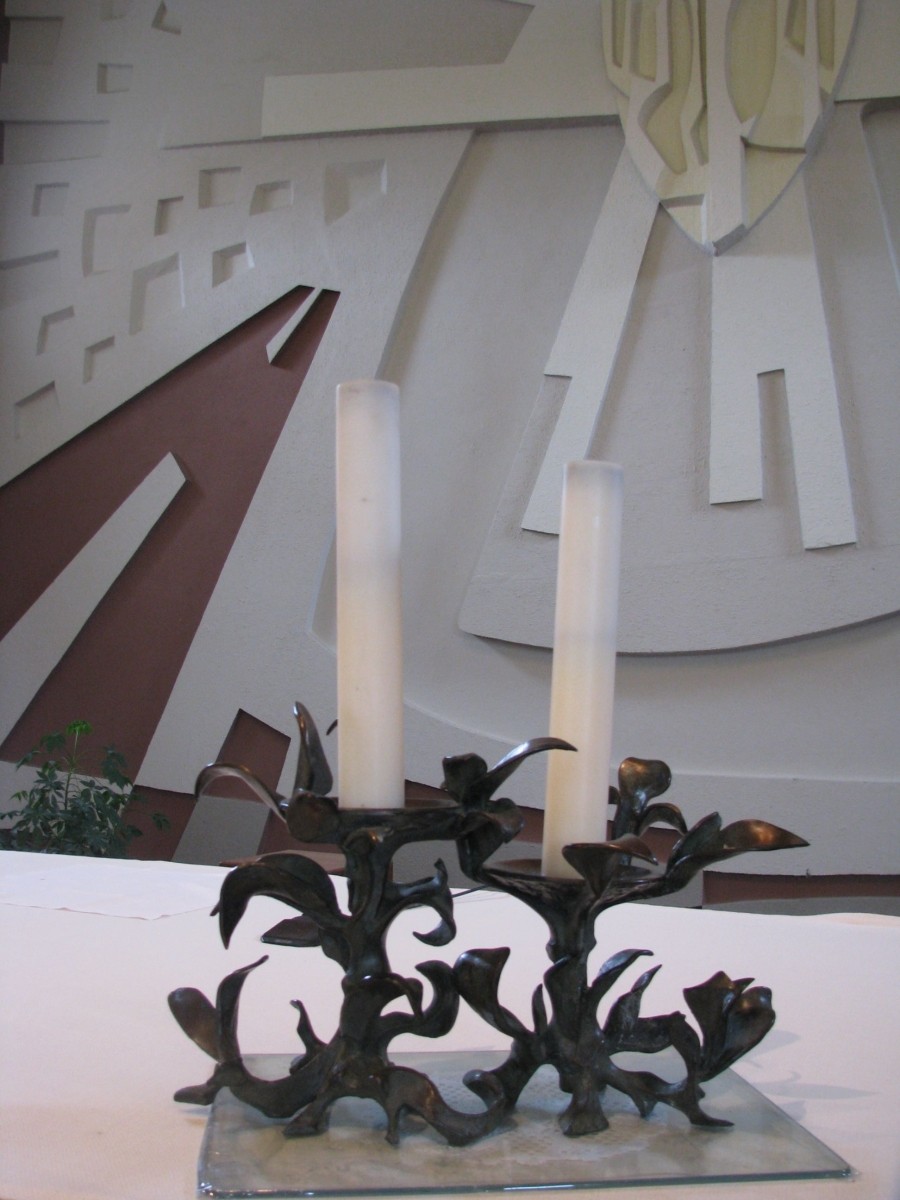
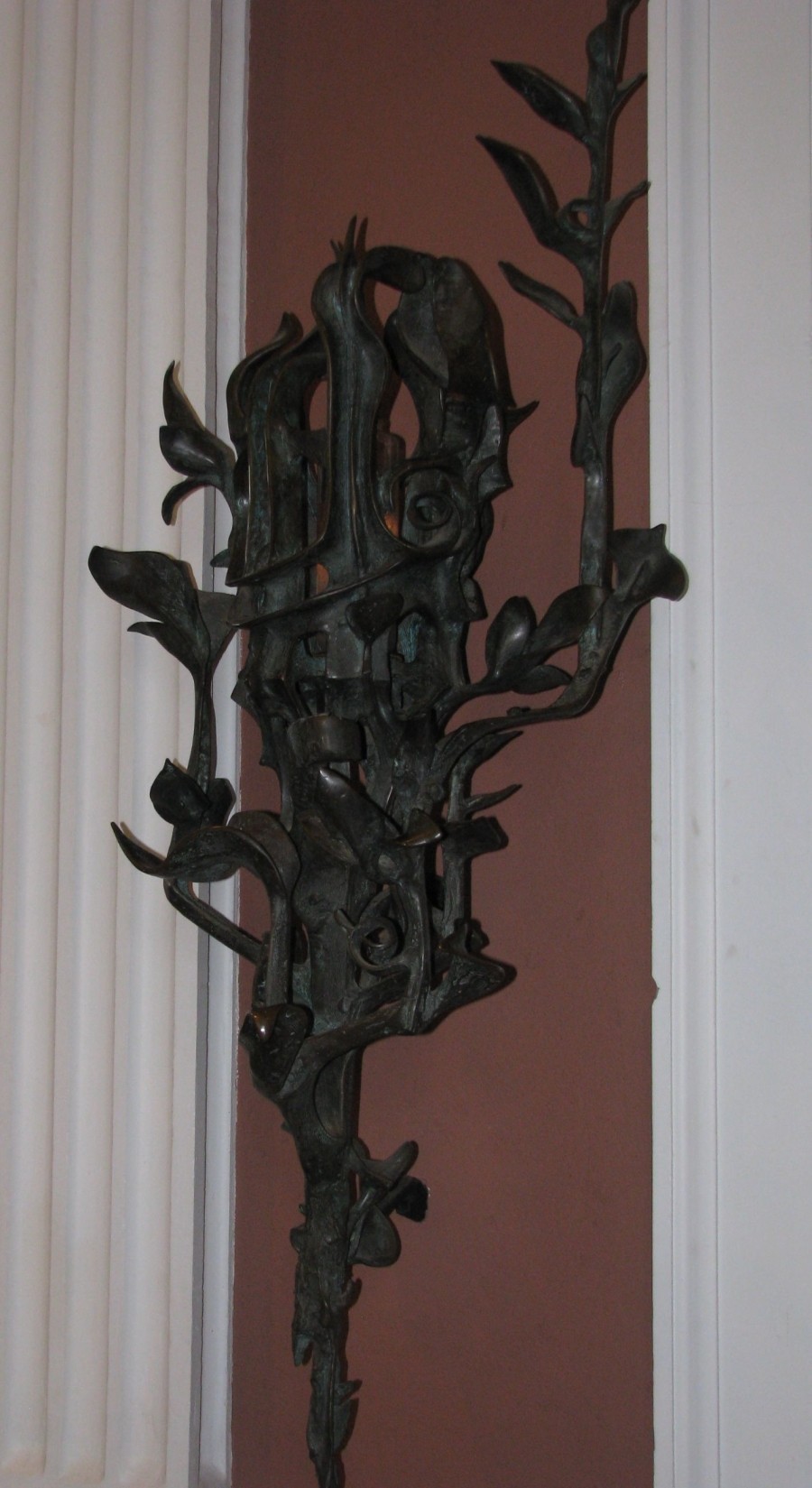
The sanctuary lamp, mandated by Canon Law, reminds believers of the Real Presence of Christ in the Blessed Sacrament. The hidden world of the Eucharist is holy ground, and the sculptor, Maria Gamundi Neiman, chose the burning bush motif for her one of a kind sanctuary lamp crafted in bronze. (Exodus 3:1-6) Bracketed to the wall, it appears to be alive and growing. A companion piece, a bronze Candelabrum by the same artist, adorns the altar. These pieces bring to mind Elizabeth Barrett Browning’s famous couplet: “Earth’s crammed with heaven, and everything common brush afire with God.”
Emmanuel: Altar and lettering

In the summer of 1986, the President, Reverend Dr. Gregory MacKinnon, asked me to design a small altar to go under the tabernacle. Two designs were submitted and the present one was fabricated by the University carpenters. I took my cue from the original altar and pulpit designed by Neiman, which are no longer in the Chapel. In 1989, President MacKinnon asked me to carve the letters for Emmanuel, Hebrew for “God is with us.” I imitated the script that Angus Macgillivary had used in carving the Magnificat letters. He gave the letters a feminine, flowing character in keeping with the subject matter of the panel. In contrast, I kept the surface width of the letters close to the width of the bases. This gave the letters a straightforward and blunt appearance, the way I imagined Christ could have been at times. After Angus had died, a relative gave me his carving tools, and I was able to use them for this project.
The Magnificat Panel
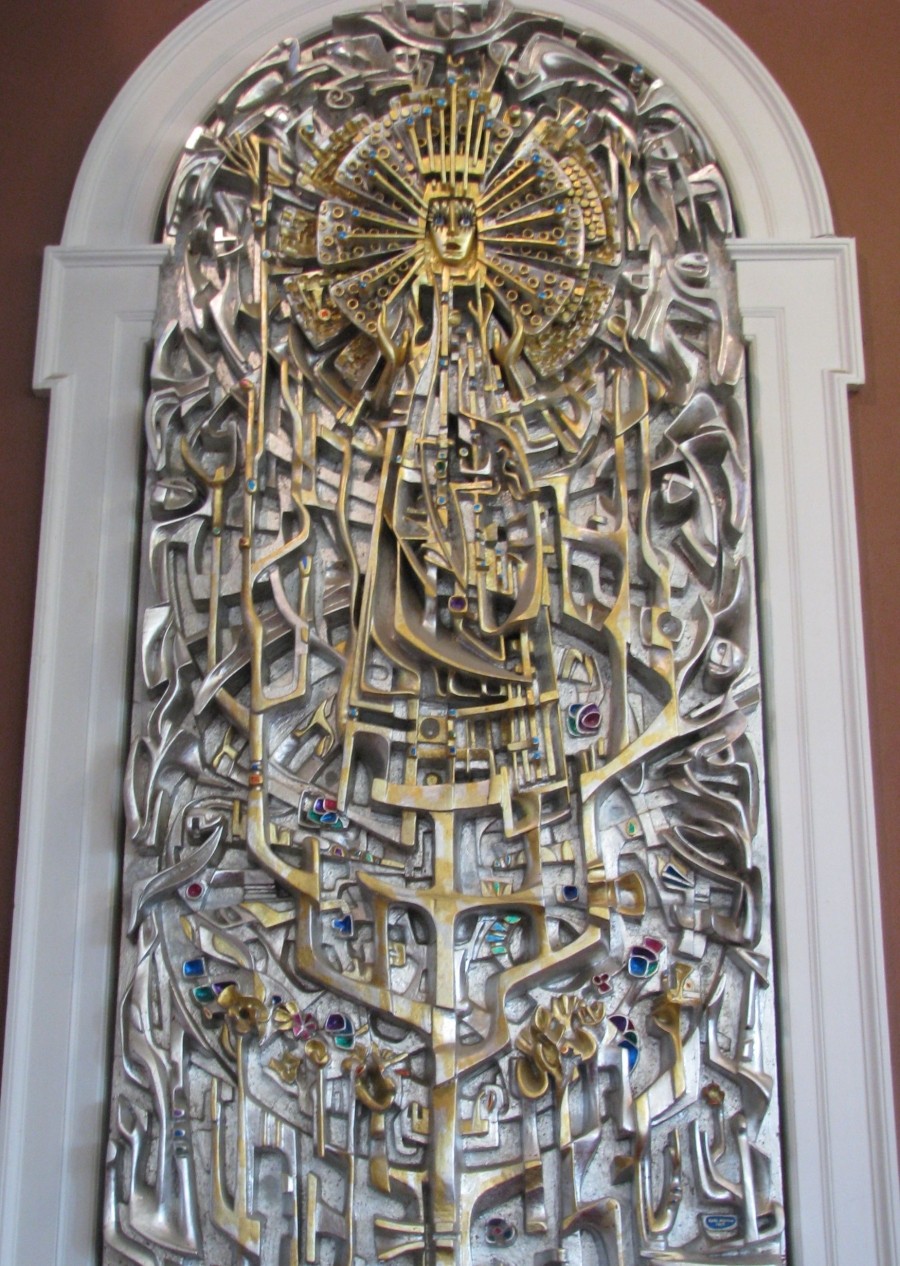
In the Magnificat, Neiman uses the symbolism of the symbolism of the Jesse tree, a genealogical device representing the lineage of Jesus. It was often used in medieval churches as a decoration for doors, walls, windows, vestments, etc. In Isaiah II, a messianic poem describes some of the characteristics of the coming Messiah. The opening lines are: “A shoot shall come out of the stump of Jesse, and a branch shall grow out of his roots: on him the spirit of Yahweh rests.” In other words the Messiah will be a Davidic stock. Jesse, King David’s father is shown as the root of the tree, symbolically representing the foundation of the family. Mary is depicted as growing from that tree or emerging from the family line. She seems amazed at the news that she will be the mother of the Messiah. The occasion for the Magnificat (“My soul proclaims the greatness of the Lord”) was Mary’s response to her cousin Elizabeth whom she visited after the Annunciation. Elizabeth greeted Mary, the living tabernacle, as “the mother of my Lord.” (Luke 1:43)
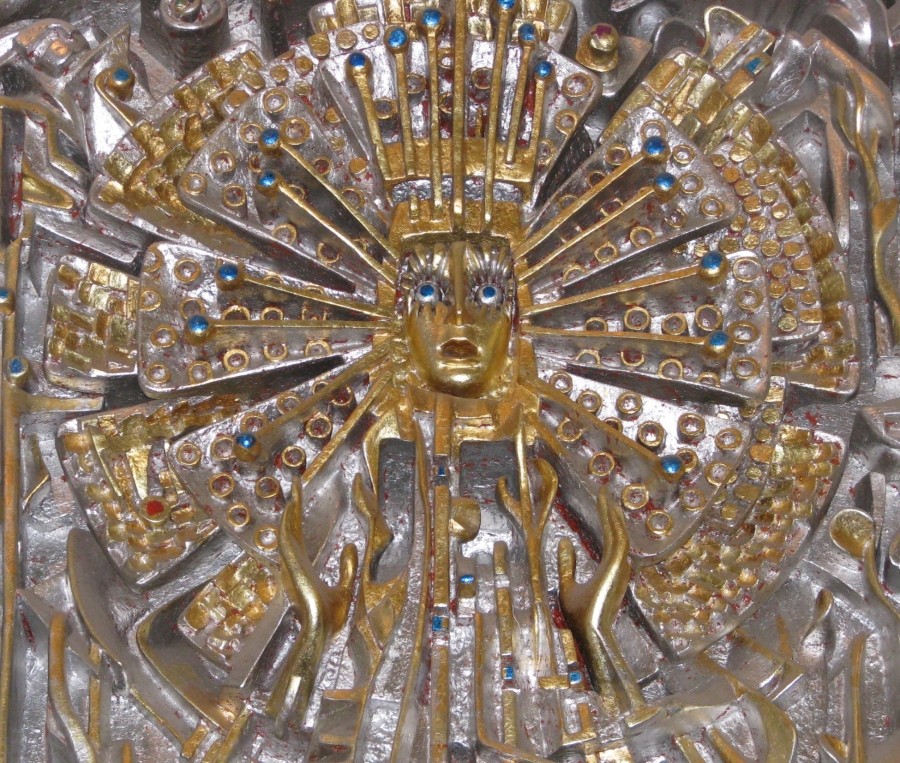
Three overlapping circles, best seen at a distance of about twenty feet, are a subtle reminder that Mary is full of grace. Neiman has put a crown on her head, a reference to the Queenship of Mary. The baroque texture of the Magnificat panel complements that of the Emmanuel, although the colours are reversed. Here it is predominantly silver with gold undertones. Once again brilliant spots of colour are scattered here and there. The central placement of the figure of Mary, and the root of the Jesse tree, helps to convey a sense of poise and balance. And a sense of nobility and regal bearing as well.
Magnificat lettering

When the Magnificat panel was first located in the east transept, Macgillivary had the title placed from left to right high up on the left side of the panel. Rather than try to cram the letters into the much smaller space next to the present site of the panel, Neiman suggested that they run from top to bottom. In keeping with the subject matter of the panel, Macgillivray carefully designed his own script and carved his letters so that they took on a slender and graceful appearance. Both sets of letters are located at the golden section, a harmonious proportion resulting from the division of a straight line (in this case the width of the niche) into two parts so that the ratio of the smaller part to the larger is the same as that of the larger to the whole.
The fourteen stations of the cross and the celtic cross
Earl Neiman suggested to Angus Macgillivray that the cross represent Christ throughout the fourteen stations. Angus envisaged the great cross at the fifteenth station, i.e., the resurrected Christ, the glorious victor over death and sin. He saw the cross as a sign of hope, because on it was accomplished the saving plan of the love of God. If Angus had started the stations in the northeast corner and followed the traditional placement of seven stations on each side, he would end up with the last station in the northwest corner, visually distant and separated from the Celtic cross. He came up with the idea of placing all fourteen stations on the east side, so that that the east transept, he could build momentum toward the great cross by the varying the scale, placement and direction of the last few stations. Despite the Roman numeral, people making the Stations often got mixed up and couldn’t remember what each cross signified. In 2003, the present Chaplain, Father Paul MacNeil solved the problem by having a small set of realistic stations discreetly below the abstract ones. Now a person praying the devotion can easily check the smaller station, and then look up to see how the artist interpreted it.
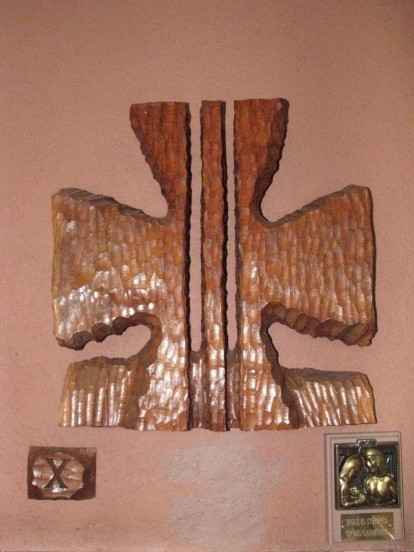
The task of carving these abstract stations imposed considerable restraints on Macgillivray. He was limited to the elements of line, shape and texture. He could leave the surface bare, carve lightly on it, cut deeply into it and even cut right throughout the back. The diagonals are used a lot to suggest the weight of the cross that caused Jesus to fall several times, but sometimes they almost disappear as in the sixth station where Veronica offers her veil. For a brief respite, Christ seems to draw strength from this act of charity. A wonderful tribute to all women. At the tenth station, the stripping of the garments of Christ, Macgillivray makes daring cuts right through to the wall. Jesus stands naked and alone, without the background of his creation. He was despised and rejected of men, a man of sorrows, and acquainted with grief. At the twelfth station, Macgillivray places the cross even higher on the wall to represent the crucifixion on Calvary. There is no deep undercutting around the cross and it is not separated from the background, because all creation is embraced in the saving act. No longer do the lines in the cross cut deeply into the surface. The vertical lines are spent and drained of life. An eerie stillness and quiet emanates from the cross at this station. Christ has died.
The fifteenth station: Christ is risen
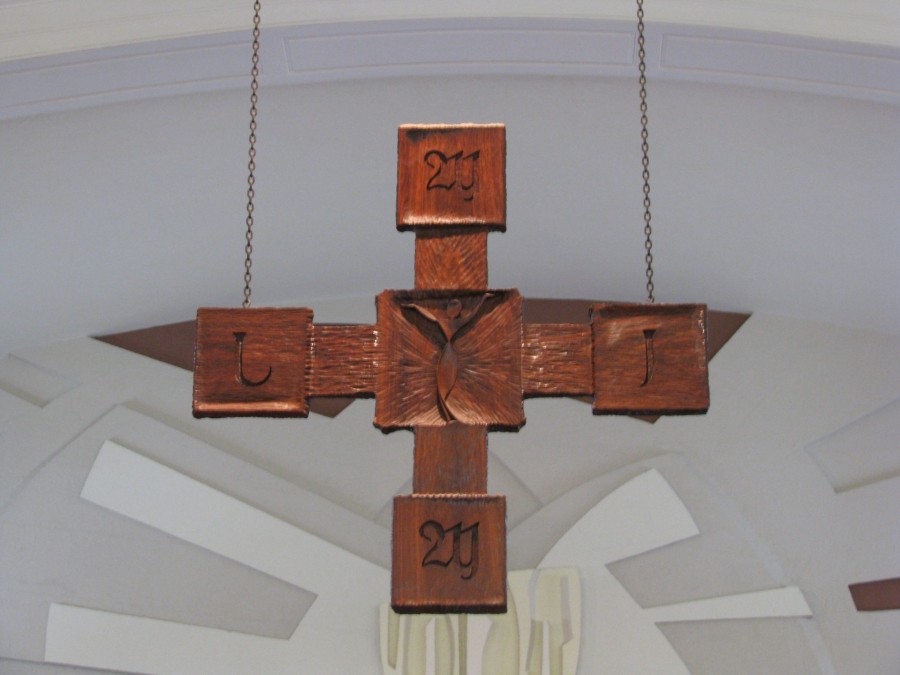
The Cross is representing Redemption shows God the Son, the Word made partaker of creation in flesh, rising from the tree of that creation in glory. The bearers of the word, the Evangelists, are presented in the extremities of the Cross by letters from an ancient Gaelic alphabet, the Bobellloth. It only had 18 letters, and there was no equivalent for our J. The characters symbolized trees and shrubs: Matthew and Mark by “M” – the vine; Luke by “L” – the hawthorn; and John by “I” – the ivy.
The vertical and horizontal arms overlap at the centre. The vertical arm has the M, the risen Christ figure, and the other M. The horizontal arm has the L, the I, and the initials FX on the back. Two black chains hold the cross, and they blend with the lamp chains throughout the Chapel. The dark wood of the cross goes with the wood of the main altar, the lectern, the lettering and the tabernacle. The scale of the cross is perfect for the size of the mural behind, and the height of its suspension and distance from the Parousia mural are just right. Christ has conquered sin and death. The Altar Cross radiates dignity, integrity, majesty, quiet joy and peace. All these qualities only hint at what awaits those who take up their cross daily and follow the Lord, Who is the Way, the Truth and the Life.
Stained glass windows
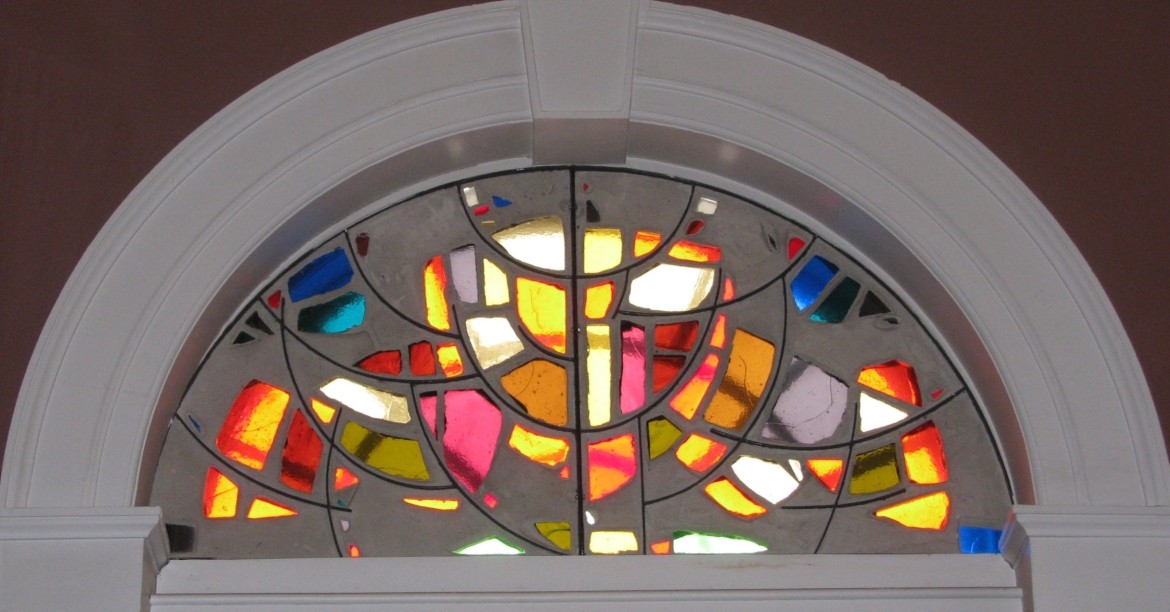
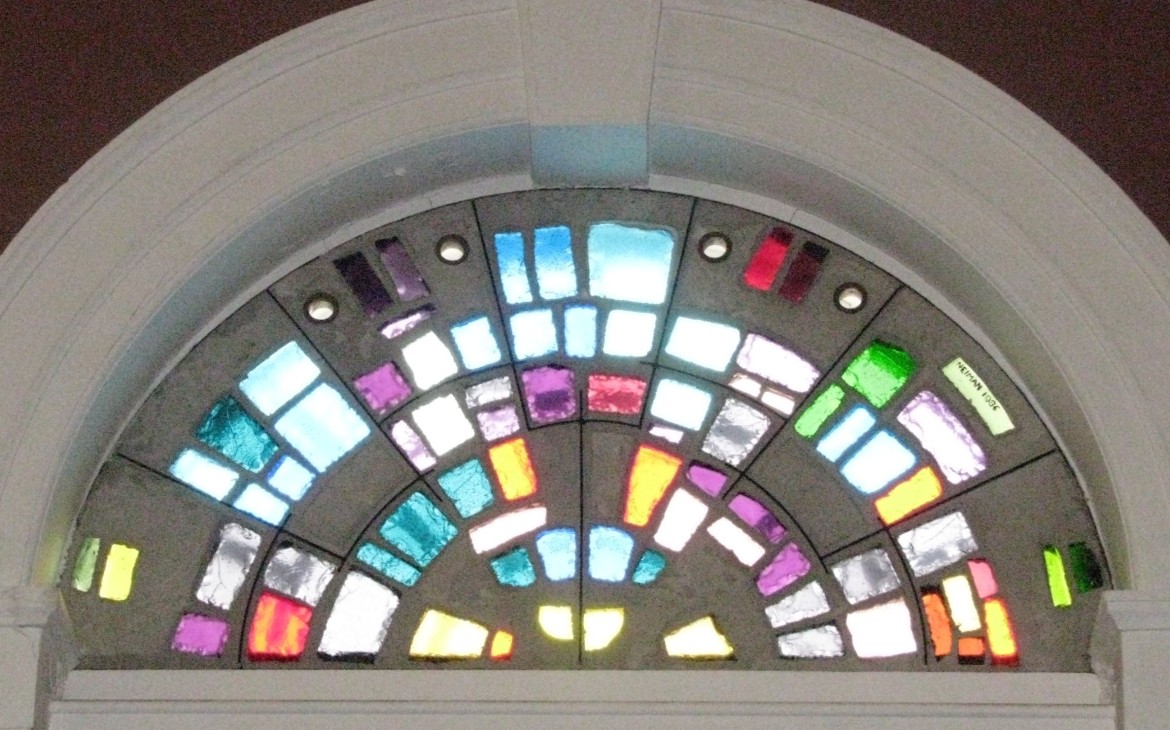
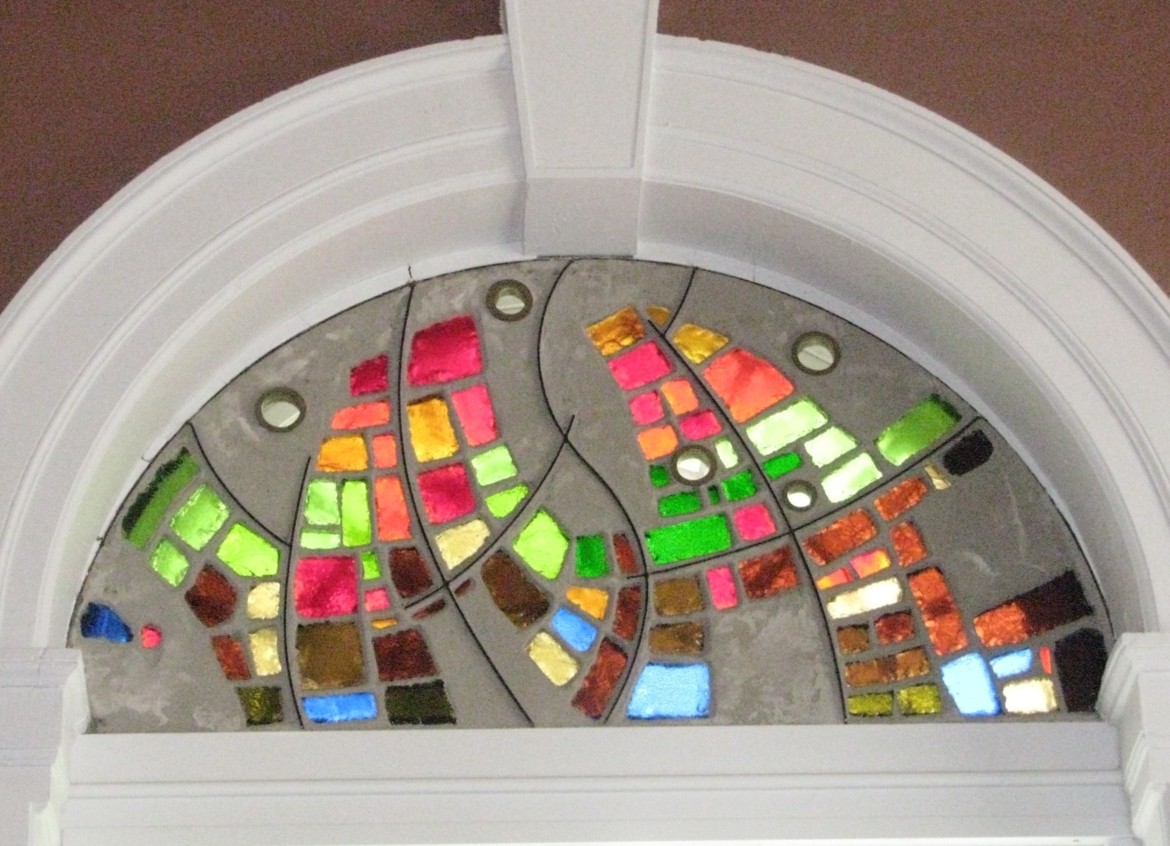
Earl Neiman and Maria Gamundi Neiman worked with a blacksmith to fabricate the half-moon frames with their decorative and supporting grill work. They then set in cement that one-inch thick sections of Dalles glass. Neiman said that he wanted to send a bit of Italian sunshine to Nova Scotia via these sculptural windows. Whereas the Emmanuel window has a full spectrum of colours symbolic of the perfection of Christ, the Magnificat window has mainly purples, greens and blues; a reminder that Mary is the Mother of Sorrows. The dominant colours in this pair of windows also form a warm/cool contrast. The third window is a visual play on the name Xavier. Besides picking up some of the colours of the other two windows, the artists added several brown tones to go with the patina on the sculpture of St. Francis Xavier.
Bronze sculpture of St. Francis Xavier
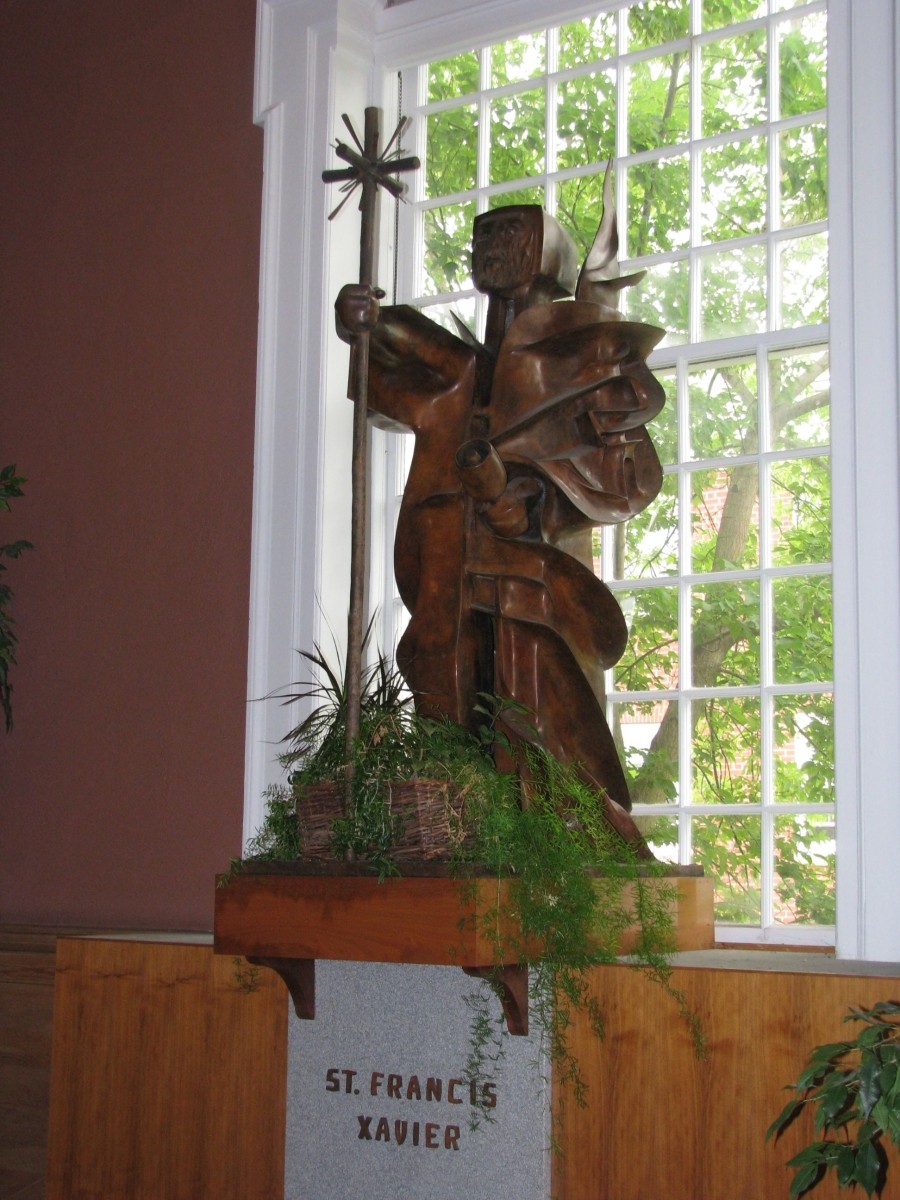
This sculpture was poured at a foundry in Monteggiori, Italy, shipped across the Atlantic, and transported to its present site in January, 1988. The process used for making the sculpture is called cire perdue (lost wax). The workers pour the molten metal over a core within a mould, in the space created by melting and running out the original wax surface of the model. Although the method is quite complicated, it has one great advantage, especially in casting larger figures; it takes far less metal than the method of solid casting, and the danger of cracking during the cooling process is lessened. Maria Gamundi Neiman worked her smaller pieces, the sanctuary lamp and the candelabrum, directly in wax to save costs (larger bronze usually require several molds), so that only one of a kind was possible in those two works. Earl Neiman’s Xavier is hollow and one can put a hand inside to feel the thickness of the bronze which replaced the wax that once was there. The model was divided into fragments, top and bottom, right arm, cross and bell. After the bronze sections cooled off and the shells were removed, the pieces were welded together and the “chasing” (refining and finishing) was done. The last step is the application of the patina which gives the work its colour and preserves the finish.
The following description is in a frame hanging on the side wall near the sculpture: “St. Francis Xavier, a native of Navarre in Spain and a charter member of the Society of Jesus, went as a missionary to India in 1541. For Eleven years he labored in India and Japan. While awaiting an opportunity to continue his work in China, he died suddenly on an island off the Chinese coast. He was 46. The two worlds faced by St. Francis Xavier are represented by this bronze statue: the world of faith on its right and the world of infidelity on its left. These worlds are clearly separated, but not in the head nor mind of the Saint. On the right, he holds the cross of Christ, the instrument capable of making the two worlds one. On the left, he holds a bell to call his flock to hear the Gospel of Christ. The peace that only Christ can give is represented by the serene, flowing garments on his right.”
It is instructive to compare the two sides to see how Neiman has created these effects through his manipulation of line, shape and texture. The ancient adage, “abstractio non est mendacium,” (abstraction is not a lie), applies to this sculpture. The sculptor is not particularly interested in presenting a realistic picture of the saint, but he is fascinated at what drives a man to go half way around the world to spread the Gospel. Xavier didn’t mind being regarded as “a fool for the sake of Christ,” and Neiman tries to portray this divine madness. The saint is on fire with the Spirit, and his cowl licks the air like flame. Neiman made the forehead in the shape of a Tau cross to symbolize that the cross was nearly an obsession in the mind of St. Francis Xavier. His eyes are riveted on the cross. Xavier’s indomitable right arm juts straight out like a great steel beam. And look at the tenacious grip he has on the cross! No thing and no one will ever separate Xavier from the cross of Christ. The sculpture bears out Neiman’s contention that no more intense individual ever existed or more stubbornly purposeful. Francis Xavier gave everything he had. This is the inspiration for the “X spirit.” This is the call to service that the “X” ring represents. This is the challenge of the University’s great patron, St. Francis Xavier.
Painting of St. Francis Xavier
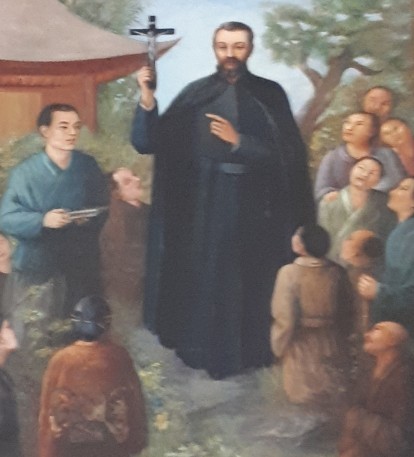
In 1924, Rev. Dr. Hugh P. MacPherson, Rector of St FX, desired to have an original painting of St. Francis Xavier to place above the altar in Somer's Chapel. Mother Mary Faustina MacArthur, Mother General of the Sisters of St. Martha, recommended to Dr. MacPherson that he contact her cousin, Sr. Mary Aloysius Gonzaga, S.P., of Boston. Sr. Mary Aloysius was studying under the guidance of Ms. Helen Todd Hammond, and during an art lesson Mr. P.E. Duffey, a famous art dealer, entered the studio. Sr. Mary Aloysius recognized that Mr. Duffey's stature and features resembled those of St. Francis Xavier. Duffey agreed to pose for her and arranged for a young Japanese catechist to pose for the figure on the right of St. Francis Xavier.
Boston art dealers who visited the studio expressed an interest in exhibiting the painting in their city before it was shipped to Canada. Eventually, the painting arrived in Antigonish in perfect condition. Dr. MacPherson expressed his appreciation to the artist, and the painting was hung above the altar in Somer's Chapel. When the new University Chapel was built, the painting was stored in a closet in Somer's Hall until it was eventually rediscovered, restored, and for many years was hung in the Angus L. Macdonald Library before its move to its present location.
Sr. Mary Aloysius Gonzaga, S.P., was born Margaret Ann MacArthur on 6 June 1870 in Merigomish, NS. She joined the Sisters of Providence and lived and worked in Brightside, Holyoke, MA.
Acknowledgements:
With the exception of the above description of the painting of St. Francis Xavier which is displayed in the loft, all other information is quoted from: Roach, Thomas E. The Jewel of the Campus: A History of the St. Francis Xavier University Chapel and Its Art. Antigonish, NS: St. Francis Xavier University Press, 2009. Print.
Contact
306 Bloomfield Centre
5555 Union Place
Antigonish NS B2G 2W5
Canada

